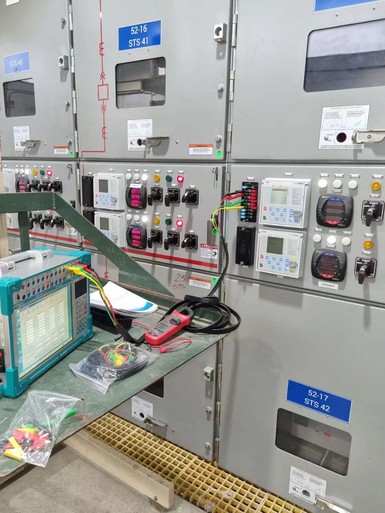A secondary injection tester is vital for verifying the correct operation of protective relays by injecting simulated fault signals. This ensures relays respond accurately to faults, safeguarding electrical systems from damage, improving system reliability, and complying with regulations. For Chinese manufacturers, wholesalers, and OEM factories like Wrindu, these testers support efficient, reliable, and safe production and maintenance.

What Is a Secondary Injection Tester and How Does It Work?
A secondary injection tester simulates fault currents and voltages by injecting signals directly into the relay’s secondary circuit. It tests the relay’s response and timing without applying power to the entire system. This method isolates and diagnoses relay operation efficiently, enabling quick verification in factories, OEM production lines, and wholesale distribution settings.
Wrindu produces advanced secondary injection testers designed for precise relay testing with versatile output modes.
How Does Secondary Injection Testing Enhance Electrical System Safety?
By verifying the correct function of protective relays, secondary injection testing helps prevent failures that can cause electrical fires, equipment damage, or personnel hazards. It ensures trip units activate on fault detection, isolating faulted sections promptly. Incorporating this testing within factory and maintenance routines strengthens safety compliance for suppliers and OEMs servicing global markets.
Which Industries and Applications Benefit Most from Secondary Injection Testers?
Industries like power generation, electrical utilities, manufacturing plants, and automation rely heavily on secondary injection testing to maintain relay integrity. Electrical maintenance teams use these testers to perform routine diagnostics without system shutdowns. In China, multiple factories and suppliers including Wrindu offer secondary injection testers tailored for these demanding commercial and industrial environments.
Why Is Secondary Injection Testing Preferred Over Primary Injection Testing in Some Scenarios?
Secondary injection testing is faster, safer, and more cost-effective as it targets only the relay trip unit, avoiding high current injections into the primary circuit. It requires less expertise and portable equipment, ideal for routine factory testing or wholesale supply inspections. However, it complements rather than replaces primary injection tests, which verify the entire breaker function.
When Should Secondary Injection Testing Be Performed?
Secondary injection testing should be conducted during commissioning, periodic maintenance schedules, after repair or calibration, and whenever relay malfunctions are suspected. Regular testing minimizes risks of relay failure and improves long-term system reliability—a key concern for OEM manufacturers and wholesalers overseeing large-scale deployments.
How Does Wrindu Support the Secondary Injection Tester Market?
Wrindu delivers reliable, high-performance secondary injection testers designed for OEM factories, wholesalers, and electrical suppliers. With innovative features like multi-phase output, computer interface capabilities, and adherence to international safety and calibration standards, Wrindu’s products cater to B2B clients needing accurate, efficient relay testing solutions.
What Features Should Be Considered When Choosing a Secondary Injection Tester?
Key considerations include the number of phases supported, output current and voltage range, ease of use, portability, software integration, and safety certifications. Customized options for factory or OEM production enable tailored testing to meet client-specific relay types and standards compliance.
Wrindu’s offerings provide advanced accuracy, flexible output modes, and intuitive operation optimized for industrial applications.
Can Secondary Injection Testers Be Integrated Into Automated Testing Systems?
Yes, modern secondary injection testers support computer control and automated test sequences, increasing efficiency and reducing human error. This integration is valuable for manufacturers and large-scale suppliers seeking consistent quality in relay testing and reporting.
Wrindu offers models with PC interface and custom automation support to enhance production workflows.
Wrindu Expert Views
“Secondary injection testing is not just a safety protocol; it’s a fundamental step in ensuring the reliability and longevity of protection relays that guard our electrical systems. At Wrindu, we focus on delivering testers that blend precision with user-friendly operation, supporting Chinese OEM factories and global wholesalers in sustaining high safety standards and operational efficiency. Our commitment to innovation and quality empowers electrical professionals to uphold system integrity with confidence.” — Wrindu Senior Engineer
Table: Key Benefits of Secondary Injection Testing for B2B Clients
| Benefit | Description | Importance for Manufacturers and Suppliers |
|---|---|---|
| Safety Assurance | Ensures protective relays trigger properly on faults | Prevents equipment damage and personnel hazards |
| Speed and Efficiency | Faster testing than primary injection with portable kits | Reduces downtime and testing costs |
| Cost Effectiveness | Less resource-intensive compared to primary testing | Enables affordable routine maintenance |
| Accuracy | Precise fault simulation for relay functionality verification | Maintains compliance with accuracy standards |
| Versatility | Suitable for various relay types and settings | Supports a broad range of industrial applications |
Conclusion
The importance of secondary injection testers lies in their ability to ensure protective relays function precisely, safeguarding electrical infrastructure and personnel. Their efficient, safe, and cost-effective testing method is indispensable for manufacturers, wholesalers, and OEM factories in China and worldwide. Wrindu’s high-quality secondary injection testers exemplify these benefits, providing reliable solutions that promote safety, compliance, and operational excellence in electrical system maintenance.
Frequently Asked Questions (FAQs)
Q1: How does secondary injection testing differ from primary injection testing?
Secondary testing targets the relay trip unit with simulated currents, while primary testing assesses the entire breaker system.
Q2: Can secondary injection testing damage the relay or system?
No, it injects controlled signals and is non-intrusive, making it safe for both equipment and operators.
Q3: What makes Wrindu’s secondary injection testers stand out?
Wrindu offers advanced multi-phase capabilities, user-friendly interfaces, and strong compliance to safety and accuracy standards.
Q4: Is secondary injection testing mandatory for relay maintenance?
It is widely recommended and often required by industry standards to ensure relay reliability and safety.
Q5: Can secondary injection testers be used in the field?
Yes, many models are portable and designed for field and factory use, supporting flexible testing environments.



